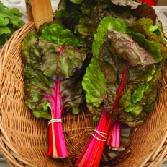-
CATEGORY ::
- All Seeds /
- All Ground Cover Seeds





Melampodium Derby Seeds
SEASON
Annual
USDA ZONES
4 - 9
HEIGHT
12 inches
WIDTH
12 - 18 inches
BLOOM SEASON
Spring through fall
BLOOM COLOR
Golden yellow
GROWTH RATE
Moderate
ENVIRONMENT
Full sun to partial shade
DEER RESISTANT
Yes
LATIN NAME
Melampodium paludosum
SEASON
Perennial
USDA ZONES
3 - 8
HEIGHT
4 inches
WIDTH
4 inches
BLOOM SEASON
Spring and summer
BLOOM COLOR
White
ENVIRONMENT
Full sun to partial shade
SOIL TYPE
Well-drained, pH 5.8 - 6.8
HOUSE PLANT
No
DEER RESISTANT
Yes
SEASON
Perennial
USDA ZONES
5 - 9
HEIGHT
4 - 6 inches
WIDTH
12 - 16 inches
BLOOM SEASON
Early to late Summer
BLOOM COLOR
White
ENVIRONMENT
Full sun
DEER RESISTANT
Yes
SEASON
Perennial
USDA ZONES
7 - 9
HEIGHT
1 - 2 inches
WIDTH
6 - 12 inches
BLOOM SEASON
Summer
BLOOM COLOR
Green
GROWTH RATE
Fast
ENVIRONMENT
Partial shade to full shade
FOOT TRAFFIC
Moderate
DEER RESISTANT
Yes
SEASON
Perennial
USDA ZONES
4 - 10
HEIGHT
20 inches
WIDTH
20 inches
BLOOM SEASON
Summer through frost
BLOOM COLOR
Pink
GROWTH RATE
Aggressive
ENVIRONMENT
Full sun to partial shade
DEER RESISTANT
No
SEASON
Annual
USDA ZONES
5 - 10
HEIGHT
6 inches
WIDTH
12 inches
BLOOM SEASON
Mid summer to early fall
BLOOM COLOR
Scarlet
GROWTH RATE
Fast
ENVIRONMENT
Full sun to partial shade
DEER RESISTANT
Yes
SEASON
Perennial
USDA ZONES
5 - 11
HEIGHT
6 - 12 inches
WIDTH
12 - 24 inches
FOLIAGE COLOR
Green
FLOWER COLOR
Blue
FALL COLOR
Foliage may turn brown with cold winters
SOIL REQUIREMENT
Average, medium, well-drained soil
ENVIRONMENT
Full sun to partial shade
DEER RESISTANT
Yes
MOISTURE REQUIREMENTS
Requires weekly watering during extreme heat for first year
LATIN NAME
Liriope muscari
SEASON
Perennial
USDA ZONES
6 - 10
HEIGHT
3 inches
WIDTH
12 - 24 inches
BLOOM SEASON
Early summer to mid-summer
BLOOM COLOR
White
GROWTH RATE
Slow
ENVIRONMENT
Full sun to partial shade
FOOT TRAFFIC
High
DEER RESISTANT
Yes
LATIN NAME
Herniaria glabra
About...
Melampodium (Derby) - Start Melampodium seeds for a ground cover plant that makes a carpet of gold for any sunny location. Also known as Melampodium Butter Daisy or Melampodium Star Daisy, this little annual has 1 inch blooms that do not want to quit blooming and blooming.
MORE GROUND COVER OPTIONS
Planting Directions
TEMPERATURE
68F
AVERAGE GERM TIME
7 - 10 days
LIGHT REQUIRED
Yes
DEPTH
Cover lightly with peat moss
SOIL TYPE
Well-drained, pH 5.5 - 6.2
SOWING RATE
Approximately 200 melampodium seeds covers 10 square feet
MOISTURE
Keep soil steadily moist but not wet
PLANT SPACING
12 inches
Melampodium (Melampodium Paludosum Derby) - Start Melampodium seeds for a ground cover plant that makes a carpet of gold for any sunny location. Also known as Melampodium Butter Daisy or Melampodium Star Daisy, this little annual has 1 inch blooms that do not want to quit blooming and blooming. Melampodium Derby is the gardener's choice for a summer annual who value its low-growing, neatly-rounded habit, effortless summer-long bloom, and versatility of use. Great for containers, edging, the front of the border, ground cover plantings, and just about any other site in sunny soil. Star Daisy seeds begin blooming less than 2 months after sowing and will keep blooming even through the heat and humidity of summer time.
Butter Daisy ground cover is great for containers as well as for a sunny ground cover plant in any garden, Melampodium Derby yellow quickly grows into a neatly rounded, mounding plant with masses and masses of 1-inch daisies. It needs very little care to keep growing and blooming its best, and will self-sow freely if you let it, creating a permanent ground cover for itself in your beds and borders.
Growing Melampodium seed is so rewarding, and you will find this ground cover seed easy to germinate and eager to grow. The plants are free from insect and pest problems, but can become prey to powdery mildew in very humid, moist climates, so make sure they have good air circulation if this is an issue in your garden. This is truly one of the most low-maintenance annual ground covers that you can grow from ground cover seed. Sow Melampodium seeds indoors 7 - 10 weeks for the last expected frost date. Transplant the seedlings outdoors when frost danger has passed.































